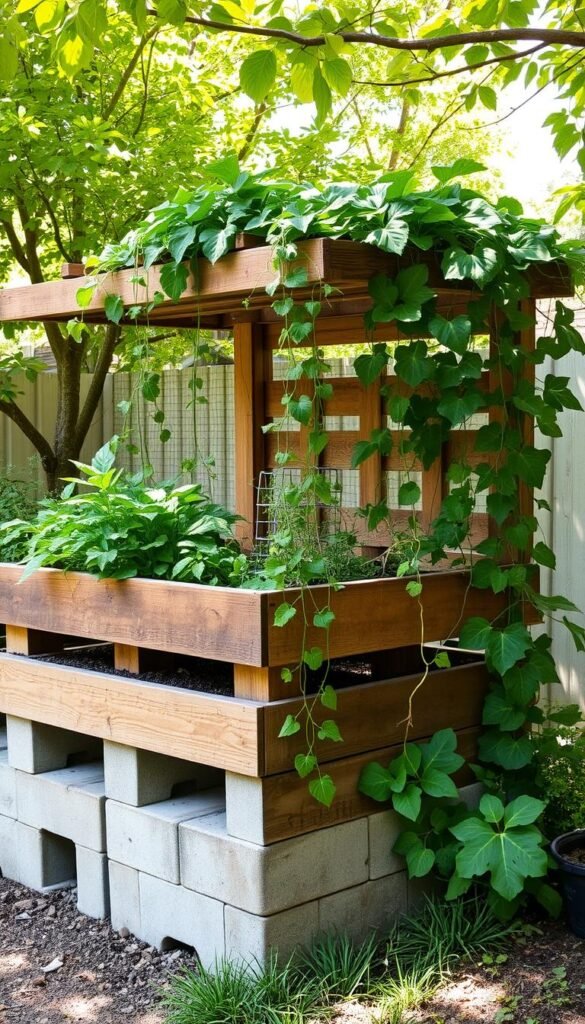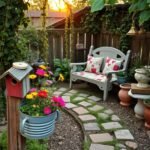Creating a thriving garden doesn’t have to break the bank. With a little creativity, you can design a productive growing area using everyday items. Many gardeners love the flexibility and control that elevated planters offer.
Why choose this approach? Elevated soil warms faster in spring, giving your plants a head start. It also reduces strain on your back since bending becomes optional. Whether you’re growing veggies or flowers, this method keeps things neat and manageable.
Repurposed wood, metal tubs, or even concrete pieces can transform your backyard. One gardener turned unused shipping crates into a lush herb haven. With smart choices, your outdoor space can flourish without a hefty price tag.
Why Choose Budget-Friendly Raised Bed Materials?
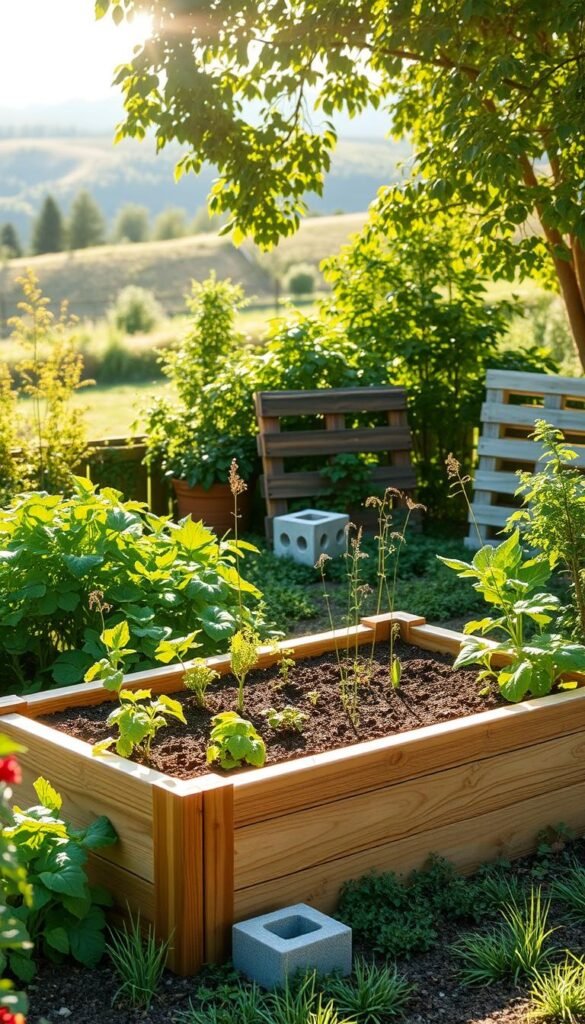
Gardening becomes simpler when you elevate your plants above ground level. This way lets you control soil quality, reduce weeds, and grow more in less space. Plus, it’s kinder to your back and knees.
Benefits of Elevated Planters
Better drainage means healthier roots. Unlike traditional plots, a raised garden prevents waterlogging. Plants get air and nutrients without competing with weeds.
In coastal areas or places with poor native soil, these beds are a game-changer. Fill them with a custom mix to give plants the perfect start. No more battling clay or sand.
You’ll also save time. Water and fertilizer stay where they’re needed. Smaller spaces mean less waste and faster growth cycles.
Cost Savings You’ll Love
Building your own garden bed cuts costs dramatically. A DIY version with wood or blocks can cost under $75, while pre-made cedar kits often exceed $300.
For example, pine boards cost $1.50 per foot and last 3–5 years—ideal for inexpensive raised setups. Learn more about building raised beds for square-foot gardening to maximize savings.
Even small investments pay off. A 4×4-foot raised bed can yield enough veggies to offset its cost in one season.
Pallets: The Ultimate Upcycled Raised Bed Solution
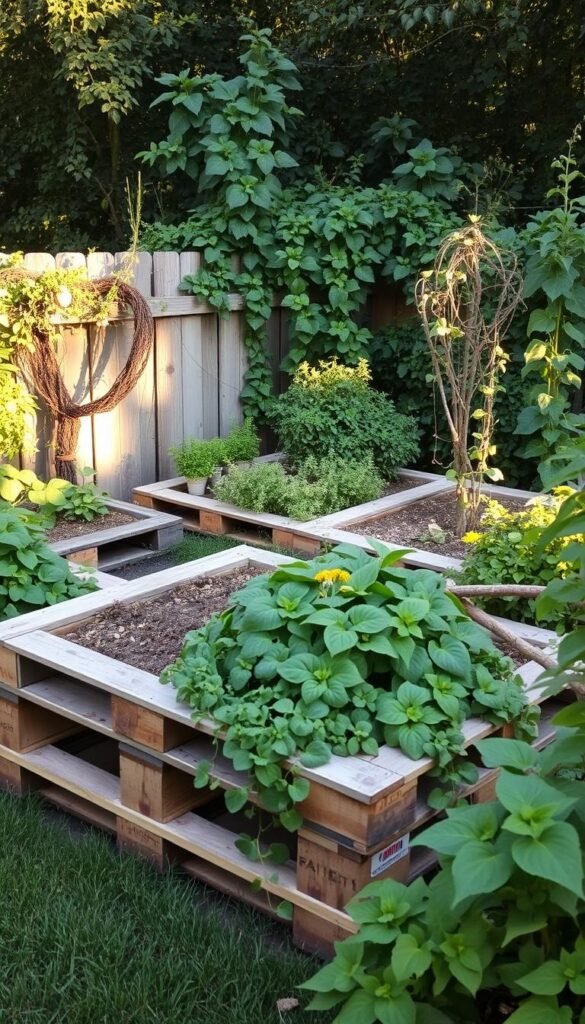
Upcycling pallets for gardening combines sustainability with smart design. These versatile structures are perfect for DIY projects, offering a sturdy base for your plants. With basic tools, you can turn them into functional, eye-catching planters.
Where to Find Free or Cheap Pallets
Check construction sites or local businesses—many give away unused pallets. Online platforms like Craigslist often list free ones. Big-box stores may leave them behind their loading docks.
Always ask permission before taking pallets. Look for the HT stamp, which means they’re heat-treated and safe. Avoid those marked MB (methyl bromide), as they contain harmful chemicals.
How to Prepare Pallets for Gardening
Disassemble them using a pry bar, hammer, and gloves. Remove nails carefully to avoid splinters. Lowe’s offers free wood cutting if you need help sizing planks.
Line the interior with landscape fabric to hold soil. This prevents weeds and keeps the structure intact. For a step-by-step guide, explore this DIY pallet planter tutorial.
Pros and Cons of Pallet Raised Beds
Advantages: They’re often free, modular, and ideal for vertical gardening. Their gaps allow air circulation, promoting healthy roots.
Drawbacks: Wood lasts 3–5 years outdoors. Untreated pallets may rot faster. Always inspect for chemical residues before use.
With creativity, pallets can transform your home garden into a productive, eco-friendly space.
Cinder Blocks: Sturdy and Simple Raised Beds
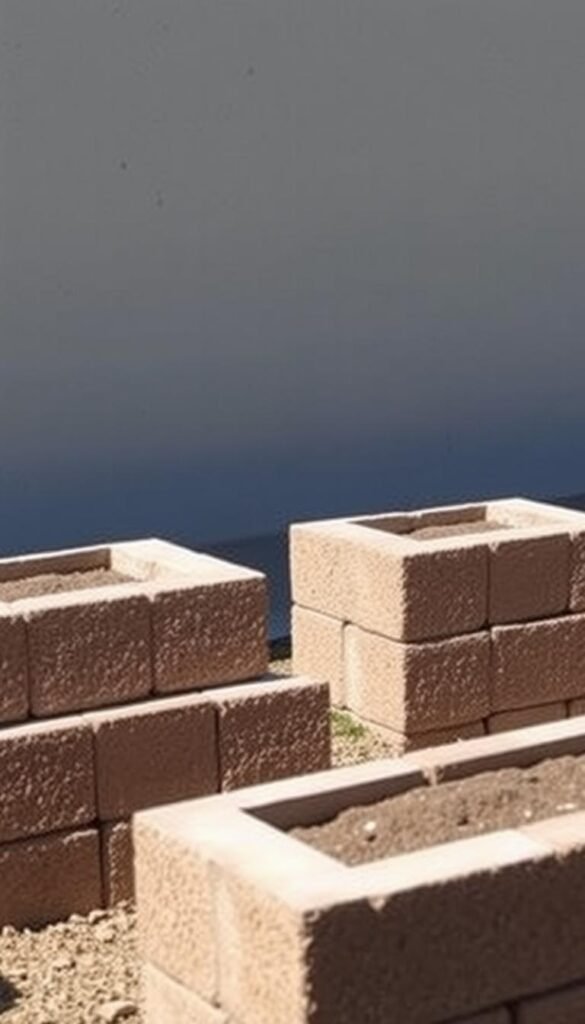
Looking for a sturdy, low-maintenance option? Cinder blocks might be your answer. These concrete powerhouses are affordable, weather-resistant, and perfect for creating structured planting areas. A basic 4’x8′ two-tier setup costs under $75 using 16 blocks and pine boards.
Design Ideas for Functional Beauty
Stagger blocks in tiers to add depth to your garden. The open cavities double as planting pockets for herbs like thyme or trailing nasturtiums. For small space, try an L-shaped layout to maximize corners.
Assembling Your Block Bed
Start by leveling the ground—a shovel and tamper are your best friends. Secure blocks with rebar driven into the soil for stability. No mortar needed! The thermal mass of concrete regulates soil temperature, protecting roots from sudden chills.
Planting in the Block Holes
Turn those hollow centers into mini gardens. Strawberries thrive here, their runners spilling over edges. For a peppery kick, plant arugula in every other hole. Just add potting mix and watch your plants flourish.
Note: These beds are heavy! Choose a permanent spot—they’re not meant to be moved once set.
Galvanized Tubs: Quick and Stylish Raised Beds
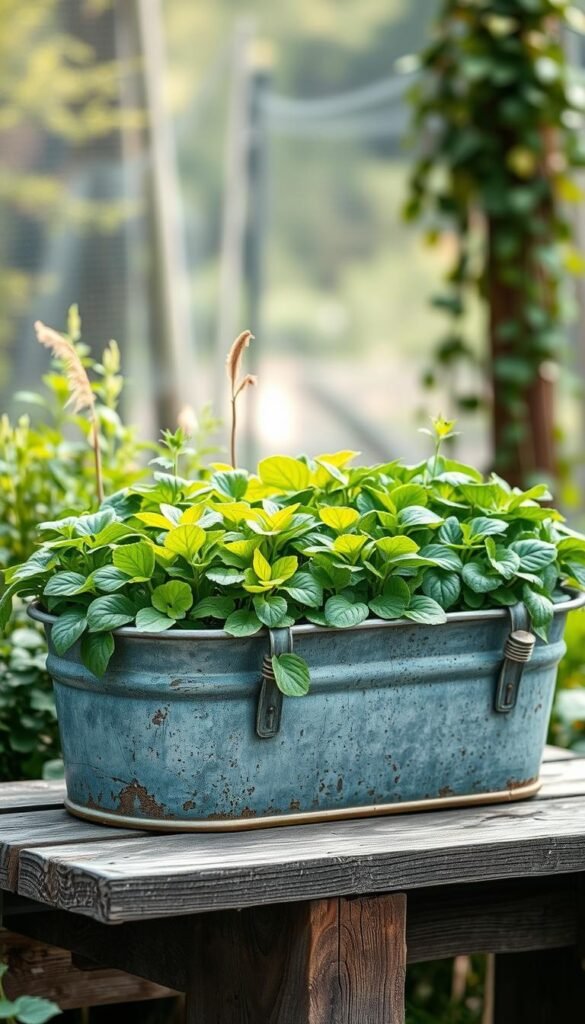
Turn ordinary metal containers into productive garden spaces with galvanized tubs. These steel planters heat soil faster than wood or concrete, giving heat-loving crops a boost. Perfect for urban balconies or deck gardens, they bring industrial charm to your growing area.
Ideal Plants for Metal Containers
Compact crops thrive in these warm environments. Try these top performers:
- Lettuce varieties: Buttercrunch grows well in shallow soil
- Radishes: Harvest in just 3-4 weeks
- Dwarf tomatoes: Patio varieties stay manageable
One gardener relocated her tubs after ducks kept bathing in them—now her herbs grow duck-free near the kitchen.
Essential Drainage for Healthy Plants
Prevent waterlogging with proper drainage holes. Use a 1/4″ drill bit to make openings every 6-8 inches along the bottom. Elevate tubs on bricks for better airflow.
Find quality containers at:
- Tractor Supply Co. for farmhouse styles
- Antique shops for vintage character
- Pottery Barn for sleek designs
Pro tip: Spray exteriors with rust-resistant paint to match your outdoor decor. Food-grade tubs are safe for edibles—just avoid using older containers that may contain lead.
Roll your planters to follow sunlight patterns. This mobility makes them perfect for renters or anyone who loves rearranging their outdoor space.
Repurposed Materials: Bathtubs, Bins, and More
Transform forgotten household items into thriving garden spaces with these clever ideas. From vintage tubs to filing cabinets, your home might already hold the perfect garden beds. These projects save money and reduce waste—win-win!
Old Bathtubs as Elevated Planters
Clawfoot tubs make dramatic herb gardens. Their depth suits deep-rooted plants like tomatoes. Elevate them on cinder blocks for better drainage and a inexpensive raised design.
Line the tub with landscape fabric to prevent soil loss. Drill holes in the bottom if none exist. One gardener grew mint in a tub—now it’s a fragrant centerpiece.
Steel Bins and Metal Containers
Galvanized bins last 20+ years outdoors. Their durability makes them ideal for diy projects. Use cattle troughs or industrial containers for a rustic look.
- Line interiors with burlap to protect plants from hot metal.
- Add wheels for mobility—perfect for renters.
- Paint exteriors with rust-resistant coatings for longevity.
Furniture Turned Plant Stations
Broken dressers? Remove drawers and fill with soil for tiered garden beds. Filing cabinets work too—just pull out drawers and drill drainage holes.
Safety tip: Avoid furniture made before 1978. Older pieces may contain lead paint.
| Material | Lifespan | Best For |
|---|---|---|
| Steel Bins | 20+ years | Herbs, leafy greens |
| Bathtubs | 10–15 years | Deep-rooted veggies |
| Wooden Furniture | 5–8 years | Flowers, strawberries |
With these ideas, your garden can be both functional and full of character. Next, we’ll explore wooden designs for every budget.
Wooden Raised Beds on a Budget

Wood offers a classic, natural look for your garden while keeping costs low. Whether you choose pine or cedar, these materials blend durability with DIY simplicity. Perfect for beginners, a wooden raised garden warms soil quickly and resists weeds.
Pine vs. Cedar: Cost and Longevity
Pine boards cost about $75 for a 4’x8′ bed—ideal for tight budgets. Untreated, they last 3–5 years. Seal them with plant-safe tung oil or Eco-Advance to double their lifespan.
Cedar, priced around $300+, naturally resists rot and insects. It lasts 10–15 years but requires a bigger upfront investment. For small projects, pine is the smarter option.
Build Your Own in 5 Steps
1. Cut the wood: Use (6) 2x6x8′ boards. Lowe’s offers free cutting—just ask!
2. Choose joints: Lap joints (interlocking) add strength; butt joints (simple overlaps) work for quick builds.
3. Assemble: Secure corners with galvanized screws. Line the interior with roofing felt to prevent rot.
4. Seal: Apply tung oil for a non-toxic finish. Reapply yearly for maximum protection.
5. Fill: Mix compost and topsoil for nutrient-rich planting.
For more home gardening ideas, explore creative ways to stretch your budget. With basic tools and a weekend, you’ll have a thriving wooden raised bed ready for seeds.
Concrete Blocks and Bricks: Durable and Affordable
Concrete and brick structures bring industrial strength to your growing space. These masonry materials withstand decades of weather while retaining heat for temperature-sensitive plants. Unlike wood that rots or metal that rusts, they offer a permanent planting solution.
Building with Modular Blocks
Retaining wall blocks create customizable layouts for any yard shape. Their interlocking design lets you build curved or angled walls without mortar. A dry-stack approach allows easy adjustments as your garden evolves.
For stability, insert rebar through the hollow centers and into the ground. The thermal mass regulates soil temperature, protecting roots during cool nights. One Colorado gardener extended her season by three weeks using this method.
Creative Uses for Bricks and Pavers
Leftover bricks make excellent edging or full enclosures. Calculate 14 standard bricks per linear foot for a single-layer wall. Old chimney bricks add rustic charm when used as decorative borders.
Consider these smart applications:
- Build seating into your design by widening the top course
- Create planting pockets in mortar-free gaps for herbs
- Use pavers as stepping stones between beds
Important note: Concrete raises soil pH over time. Test annually and amend with sulfur if needed. For acid-loving plants like blueberries, line the interior with landscape fabric.
Whether you choose uniform blocks or eclectic bricks, these materials transform your outdoor space for years. They’re the ideal option when you want structure without constant maintenance.
Fabric Planters and Portable Raised Beds
Flexible gardening solutions adapt to your space and lifestyle with fabric planters. These lightweight alternatives to traditional boxes offer unique advantages for root health and mobility. Whether you’re renting or just love rearranging your outdoor area, they provide a smart way to grow.
Why Fabric Works Wonders
The porous material prevents root circling by air-pruning them naturally. This creates denser, healthier root systems compared to plastic pots. Your plants access more oxygen and nutrients from the soil.
Ideal crops for these containers include:
- Root vegetables: Carrots grow straighter without obstructions
- Potatoes: Easy harvest by tipping the bag
- Berry bushes: Blueberries thrive in the acidic soil mix
Top brands like Root Pouch use recycled materials, while Vivosun offers budget-friendly options. Expect 5-7 years of use before UV degradation weakens the fabric.
Maximizing Portable Gardens
For easy movement, place your raised beds on wheeled pallets. This lets you chase sunlight or protect plants from storms. When winter comes, empty and fold them flat for compact storage.
These planters also serve as:
- Quarantine zones for new plants
- Pest control stations away from main gardens
- Seasonal herb stations near kitchens
One urban gardener rotates three fabric beds between her fire escape and rooftop. The setup takes minutes but yields fresh salads all summer.
How to Choose the Best Material for Your Raised Bed
Your perfect growing setup depends on matching materials to your specific needs and environment. Whether you prioritize longevity, ease of assembly, or visual appeal, each option brings unique advantages. Consider these key factors before building your garden beds.
Balancing Cost, Durability, and Style
Start by evaluating these core elements:
- Budget: Pine costs 75% less than cedar but lasts fewer years
- Climate: Metal excels in rainy areas, while concrete insulates in cold zones
- Mobility: Fabric planters move easily; block designs stay permanent
Assembly time varies dramatically. Cinder blocks snap together in an hour, while pallet projects might take three. Local availability also affects prices—urban areas often have free shipping pallets, while rural locations may favor concrete.
Align Materials With Your Gardening Vision
Match your bed depth to crop needs:
- 6-12″ for lettuces and radishes
- 18-24″ for tomatoes and carrots
Cedar suits perennial plants like asparagus, while pine works fine for annual veggies. Those in USDA zones 3-5 should prioritize insulated designs. Modular raised bed systems allow future expansion if space permits.
Remember: The best way forward combines practical needs with personal preferences. Your ideal solution exists among these versatile options.
Get Started on Your Budget-Friendly Raised Bed Today
Ready to transform your outdoor space without spending a fortune? Begin with these simple projects: pallet planters, block setups, or galvanized tubs. Each offers a quick, inexpensive raised solution for your garden.
Start small—a 4’x4’ test bed lets you experiment before scaling up. Hunt for materials on FreeCycle.org or borrow tools from local libraries. Every great harvest begins with a single seed.
Pair your new raised garden bed with nutrient-rich soil. Check our companion guide for organic mix recipes. One home gardener grew 50 lbs of squash and tomatoes in their first season!
Share your progress with #BudgetGardenBeds. Your dream garden is just a diy project away.

